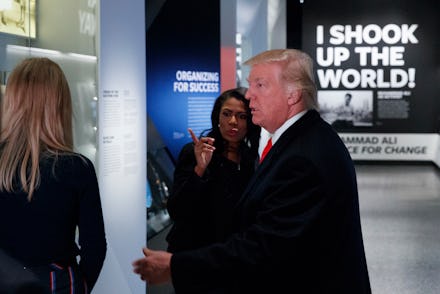Trump visits NMAAHC for Black History Month — the late Frederick Douglass would be proud

On Tuesday, President Donald Trump took a tour of the Smithsonian's National Museum of African-American History and Culture in Washington, D.C., a visit that might teach the president something about the 46.3 million Americans to whom the museum is dedicated.
"This museum is a beautiful tribute to so many American heroes," Trump said Tuesday following his more than hour-long tour during which he name-checked black icons like Sojourner Truth, Harriet Tubman and Booker T. Washington.
"I'm deeply proud that we now have a museum that honors the millions of African-American men and women who built our national heritage, especially when it comes to faith, culture and the unbreakable American spirit," Trump said, reading from prepared remarks.
Surely, Frederick Douglass, the late slavery abolitionist icon who Trump recently said was "being recognized more and more," prompting some to wonder if Trump knew who Douglass was, would have been proud to see any sitting president visiting the museum. Douglass died more than 120 years ago, decades before anyone would ever set foot inside the wildly popular Washington attraction.
During the tour, Trump and his delegation were first spotted at "The Paradox of Liberty," a slavery exhibit on slave-owning President Thomas Jefferson. Lonnie Bunch, director of the NMAAHC, told the president that he wanted to humanize the stories of those who experienced the dehumanizing institution.
"For us, this whole museum is about humanizing the stories of people who have been left out of history and making sure that you don't think about the migration of slaves," Bunch said to the president and his entourage. "You think about the individual who lived their lives."
Trump asked questions. He listened to, and later praised, Bunch. At other exhibits, he posed for pictures with members of his delegation.
Trump was accompanied by Ben Carson, the famed retired black surgeon who is the subject of a museum exhibit and who has yet to be confirmed as Trump's secretary of Housing and Urban Development. Alveda King, the controversial niece of the late Rev. Martin Luther King Jr.; Sen. Tim Scott (R-S.C.); Apprentice star Omarosa Manigault, who is a member of the White House communications staff and a Trump administration liaison to the African-American community; and Ivanka Trump, the president's daughter, were also part of the delegation.
At least three presidents were present for the museum's official opening ceremony in September, according to the Washington Post. It was President George W. Bush who signed the legislation in 2003 to create space for the museum. President Barack Obama, who is a subject of an exhibit in the museum, helped the Smithsonian break ground on the museum in 2012.
First lady Melania Trump beat her husband to the museum — she accompanied Sara Netanyahu, the wife of Israeli Prime Minister Benjamin Netanyahu, to the museum on Wednesday.
Inside, Trump saw wreckage from a slave ship and metal shackles used on captives. In all, NMAAHC lays out the harrowing and diverse story of black Americans — a story that runs contrary to the limited view often expressed by the president. Trump has repeatedly characterized the nation's inner cities and so-called "urban" areas as being the province of African-Americans, where crime, drugs, violence and poverty are ingrained, statements which offended black lawmakers and civil rights activists.
Trump also used the opportunity to finally touch upon the recent reports of anti-Semitic threats on Jewish community centers around the country, noting that the museum served as a reminder that Americans must reject racism and bigotry.
The president had been scheduled to visit the museum around the MLK holiday weekend and just before Inauguration Day. But that visit was cancelled, right around the time he took to Twitter to insult civil rights icon and Georgia congressman John Lewis, whom he blasted as "all talk" and "no action" on pressing matters plaguing his Atlanta-area district. Lewis, who is also represented in NMAAHC, was beaten during the civil rights march that helped lead to passage of the Voting Right Act in 1965.
After the museum tour, Trump pledged to protect the African-American legacy. "Today, and every day of my presidency, I pledge to do everything I can to continue that promise of freedom for African-Americans and for every American," he said.
Even after his remarks, it's hard to know if the president's views on the inner city and black communities have evolved. That evolution might require additional museum visits.
"We did a pretty comprehensive tour, but not comprehensive enough," Trump said after the visit. "I'll be back. I could stay here for a lot longer, believe me. It's really incredible."